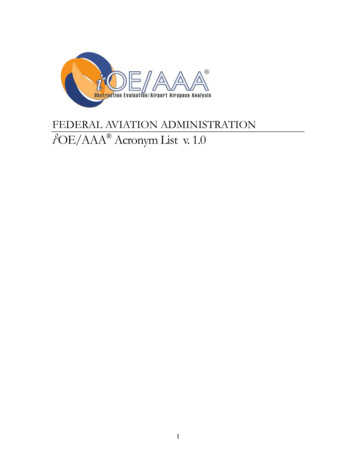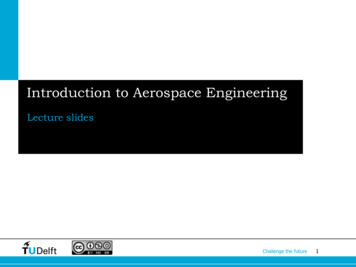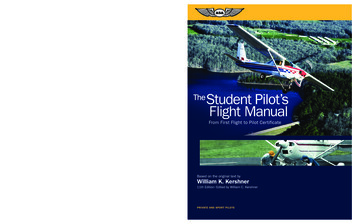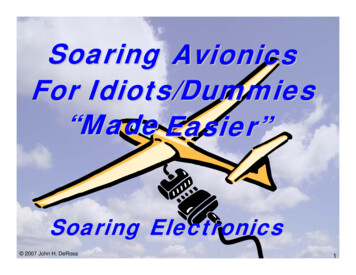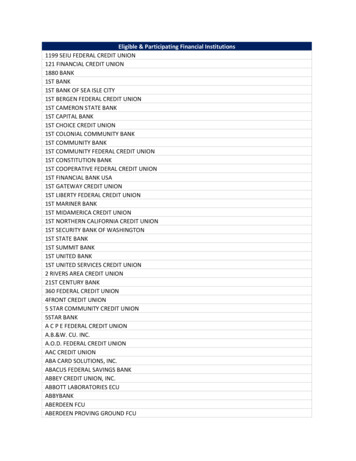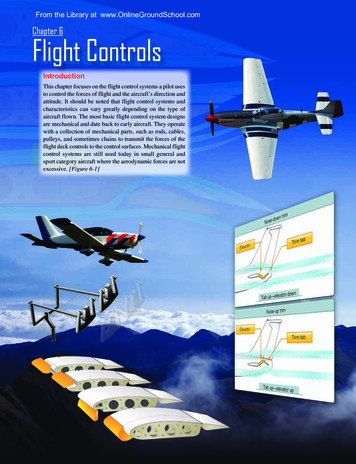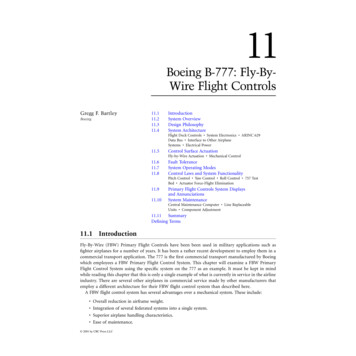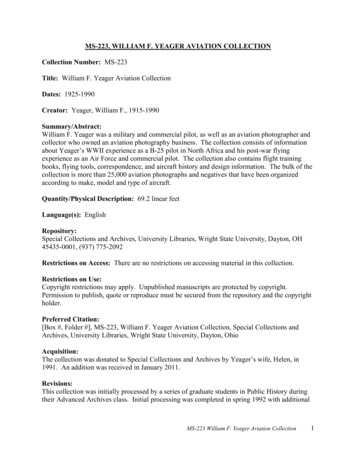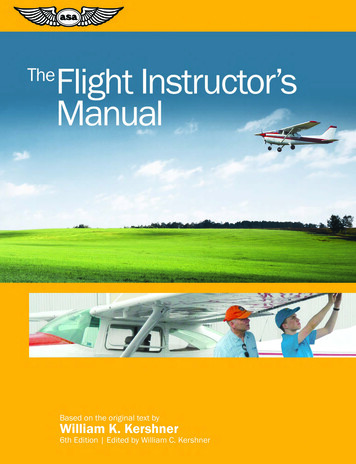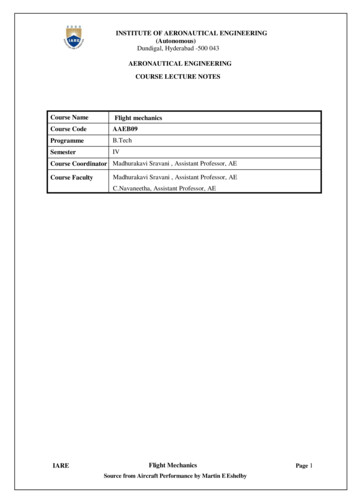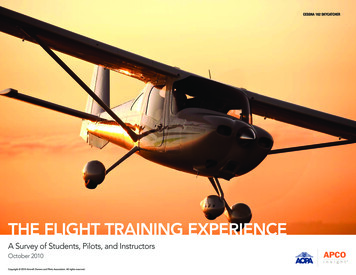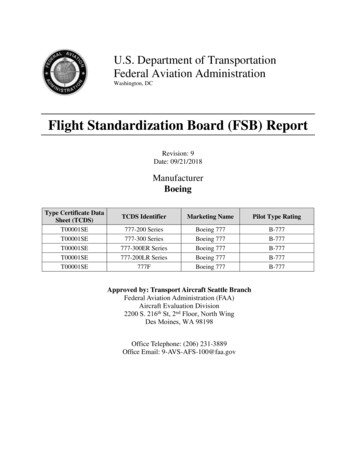
Transcription
U.S. Department of TransportationFederal Aviation AdministrationWashington, DCFlight Standardization Board (FSB) ReportRevision: 9Date: 09/21/2018ManufacturerBoeingType Certificate DataSheet (TCDS)T00001SET00001SET00001SET00001SET00001SETCDS IdentifierMarketing NamePilot Type Rating777-200 Series777-300 Series777-300ER Series777-200LR Series777FBoeing 777Boeing 777Boeing 777Boeing 777Boeing 777B-777B-777B-777B-777B-777Approved by: Transport Aircraft Seattle BranchFederal Aviation Administration (FAA)Aircraft Evaluation Division2200 S. 216th St, 2nd Floor, North WingDes Moines, WA 98198Office Telephone: (206) 231-3889Office Email: 9-AVS-AFS-100@faa.gov
TABLE OF CONTENTSSectionPage1RECORD OF REVISIONS .32INTRODUCTION .33HIGHLIGHTS OF CHANGE .34BACKGROUND .35ACRONYMS .46DEFINITIONS .57PILOT TYPE RATING .68RELATED AIRCRAFT.69PILOT TRAINING .610 PILOT CHECKING.811 PILOT CURRENCY . 1012 OPERATIONAL SUITABILITY . 1013 MISCELLANEOUS . 10APPENDIX 1. DIFFERENCES LEGEND . 12APPENDIX 2. MASTER DIFFERENCES REQUIREMENTS (MDR) TABLE. 14APPENDIX 3. DIFFERENCES TABLES . 15Page 2 of 66
1RECORD OF REVISIONSRevisionNumber0 (Original)1234567892Sections(s)Page(s) AffectedAllAllAllAllAllAllAllAll5, 6AllAllAllAllAllAllAllAllAll10, 9/21/2018INTRODUCTIONAircraft Evaluation Groups (AEG) are responsible for working with aircraft manufacturersand modifiers during the development and Federal Aviation Administration (FAA)certification of new and modified aircraft to determine: 1) the pilot type rating; 2)flightcrew member training, checking, and currency requirements; and 3) operationalsuitability.This report lists those determinations for use by: 1) FAA employees who approve trainingprograms; 2) FAA employees and designees who certify airmen; and 3) aircraft operatorsand training providers to assist them in developing their flightcrew member training,checking, and currency.3HIGHLIGHTS OF CHANGEThe purpose of this revision is to simplify the Master Differences Requirements (MDR)table and change the report into the new standardized template.4BACKGROUNDThe Transport Aircraft Seattle Branch formed a Flight Standardization Board (FSB) thatevaluated the B-777 as defined in FAA Type Certificate Data Sheet (TCDS) #T00001SE.The evaluation was conducted using the methods described in the current edition ofFAA Advisory Circular (AC) 120-53, Guidance for Conducting and Use of FlightStandardization Board Evaluations.Page 3 of 66
5ACRONYMS14 QRHRRSATCOMSUTACTCBITCDSTCPVHFTitle 14 of the Code of Federal RegulationsAdvisory CircularAirman Certification StandardsAircraft Evaluation GroupAutopilot Flight Director SystemAirplane Flight ManualAudiovisual PresentationAirline Transport PilotElectronic ChecklistElectronic Flight BagEnhanced Ground Proximity Warning SystemEngine Indicating and Crew Alerting SystemFederal Aviation AdministrationFull Flight SimulatorFlight Management SystemFlight Standardization BoardFlight Simulation Training DeviceFlight Training DeviceGeneral ElectricGlobal Positioning SatelliteHigh FrequencyHead-Up DisplayInteractive Computer-Based InstructionInstrument Landing SystemMode Control PanelMaster Differences RequirementsNational Airspace SystemNavigation DisplayPassenger AddressPrimary Flight DisplayPilot in CommandPractical Test StandardsPart Task TrainerQuick Reference HandbookRolls-RoyceSatellite CommunicationsStand-Up InstructionThrust Asymmetry CompensationTutorial Computer-Based InstructionType Certificate Data SheetTuning Control PanelVery High FrequencyPage 4 of 66
6DEFINITIONSThese definitions are for the purposes of this report only.6.1Base Aircraft. An aircraft identified for use as a reference to compare differences withanother aircraft.6.2Current. A crewmember meets all requirements to operate the aircraft under theapplicable operating part.6.3Differences Tables. Describe the differences between a pair of related aircraft and theminimum levels operators must use to conduct differences training and checking ofcrewmembers. Difference levels range from A to E.6.4Master Differences Requirements (MDR). Specifies the highest training and checkingdifference levels between a pair of related aircraft derived from the Differences Tables.6.5Mixed Fleet Flying. The operation of a base aircraft and one or more related aircraft forwhich credit may be taken for training, checking, and currency events.6.6Operational Evaluation. An AEG process to determine pilot type rating, minimumcrewmember training, checking, and currency requirements, and unique or special airmancertification requirements (e.g., specific flight characteristics, no-flap landing).6.7Operational Suitability. An AEG determination that an aircraft or system may be used inthe National Airspace System (NAS) and meets the applicable operational regulations(e.g., Title 14 of the Code of Federal Regulations (14 CFR) parts 91, 121, 133, 135).6.8Qualified. A crewmember holds the appropriate airman certificate and ratings as requiredby the applicable operating part.6.9Related Aircraft. Any two or more aircraft of the same make with either the same ordifferent type certificates that have been demonstrated and determined by theAdministrator to have commonality.6.10 Seat Dependent Tasks. Maneuvers or procedures using controls that are accessible oroperable from only one flightcrew member seat.6.11 Special Emphasis Area. A training requirement unique to the aircraft, based on a system,procedure, or maneuver, which requires additional highlighting during training. It may alsorequire additional training time, specialized training devices, or training equipment.6.12 Specific Flight Characteristics. A maneuver or procedure with unique handling orperformance characteristics that the FSB has determined must be checked.Page 5 of 66
7PILOT TYPE RATING7.1Type Rating. The Boeing 777 type rating designation is B-777.7.2Common Type Ratings. In accordance with the provisions of FAA Order 8900.1 andAC 120-53B, the B-777 and the B-787 are separate type ratings that have been determinedto have commonality.7.3Military Equivalent Designations. Military aircraft that qualify for the B-777 can be foundon the faa.gov website under Licenses and Certificates, Airmen Certification, OnlineServices, Aircraft Type Rating Designators. This webpage is kept up-to-date and can befound at http://www.faa.gov/licenses certificates/airmen certification.8RELATED AIRCRAFT8.1Related Aircraft on Same TCDS. 8.2The B-777-200 has been evaluated by the AEG as related to the B-777-300,B-777-300ER, B-777-200LR, and B-777F.The B-777-300 has been evaluated by the AEG as related to the B-777-200,B-777-300ER, B-777-200LR, and B-777F.The B-777-300ER has been evaluated by the AEG as related to the B-777-200,B-777-300, B-777-200LR, and B-777F.The B-777-200LR has been evaluated by the AEG as related to the B-777-200,B-777-300, B-777-300ER, and B-777F.The B-777F has been evaluated by the AEG as related to the B-777-200, B-777-300,B-777-300ER, and B-777-200LR.Related Aircraft on Different TCDS. The B-787 is related to the B-777. The B-777 has been evaluated by the AEG as related to the B-787.The B-787 has been evaluated by the AEG as related to the B-777.9PILOT TRAINING9.1Airman Experience.Airmen receiving initial B-777 training should have previous operational experience inmulti-engine transport turbojet aircraft, new generation avionics, high-altitude operations,electronic checklist (ECL), and flight management systems (FMS). Pilots without thisexperience may require additional training.Page 6 of 66
Airmen receiving differences, upgrade, or transition B-777 training are assumed to haveprevious experience in multi-engine transport turbojet aircraft, new generation avionics,high-altitude operations, ECL, and FMS. Pilots without this experience may requireadditional training.9.2Special Emphasis Areas.9.2.1 Pilots must receive special emphasis on the following areas during ground training: ECL. Paper quick reference handbook (QRH) backup for the ECL should also betrained. This item must be included in initial training.Tuning control panel (TCP). This item must be included in initial training.Display management. This item must be included in initial training.Engine variants (General Electric (GE) or Rolls-Royce (RR)) if in the same fleet.Pilots should be exposed to the alternate engine indicating and crew alertingsystem (EICAS) presentations by means of photos, drawings, or graphic mediawhich would assure proper display interpretation and use by the flight deck crew.This item must be included in initial training.9.2.2 Pilots must receive special emphasis on, and perform the following areas during,flight training: 9.3Flight control modes. This item must be included in initial and recurrent training.Envelope protection. Aircraft response to bank angle indications and protection,thrust asymmetry protection, enhanced underspeed (stall), and overspeedprotection. This item must be included in initial training.Fly-by-wire speed stability characteristics and aircraft trimming. This item mustbe included in initial training.Thrust asymmetry compensation (TAC). The B777 additionally incorporates aTAC system which significantly reduces uncommanded flight path changesassociated with an engine failure. Training should encompass both TAC ON andTAC OFF operations. This item must be included in initial training.Specific Flight Characteristics.Maneuvers/procedures required to be checked as referenced in the airline transport pilot(ATP) and type rating practical test standards (PTS) or Airman Certification Standards(ACS), as applicable, and/or 14 CFR part 121 appendix F.There are no specific flight characteristics.9.4Seat Dependent Tasks.There are no seat dependent tasks.Page 7 of 66
9.5Regulatory Training Requirements which are Not Applicable to the B-777 (Part 121appendix E).Tuck and Mach buffet. Demonstration of the aircraft’s overspeed protection capabilities isan acceptable substitute.9.6Flight Simulation Training Devices (FSTD).There are no specific systems, procedures, or maneuvers that are unique to the B-777 thatrequire a specific FSTD for training.9.7Training Equipment.There are no specific systems or procedures that are unique to the B-777 that requirespecific training equipment.9.8Differences Training Between Related Aircraft.Pilots must receive differences training between the B-777-200 series, the B-777-300, andthe B-777-300ER. The level of training is specified in Appendix 3, Differences Tables.Pilots must receive differences training between the B-777 and B-787. The level oftraining is specified in Appendix 3.10PILOT CHECKING10.1 Landing from a No-Flap or Nonstandard Flap Approach.The probability of flap extension failure on the B-777 is remote due to system design.Therefore, demonstration of a no-flap approach and landing during pilot certification or a14 CFR part 61, § 61.58 proficiency check, part 91, § 91.1065 competency check,part 121, §121.441 proficiency check, part 125, § 125.287 competency check, or part 135,§ 135.293 competency check is required. Refer to Order 8900.1, Volume 5 when the test orcheck is conducted in an aircraft versus a full flight simulator (FFS).10.2 Specific Flight Characteristics.There are no specific flight characteristics.10.3 Seat Dependent Tasks.Maneuvers/procedures required to be checked as referenced in the ATP and type ratingPTS or ACS, as applicable, and/or part 121 appendix F.There are no seat dependent tasks.Page 8 of 66
10.4 Other Checking Items.a) Proficiency with manual and automatic flight. Initial and recurrent checking.b) FMS operation and FMS failures. Initial and recurrent checking.c) Use and knowledge of map displays, raw data, flight director, and Autopilot FlightDirector System (AFDS) should be demonstrated, particularly during instrumentapproaches. All types of checking.d) FMS/Global Positioning Satellite (GPS) navigation (departures and approaches)proficiency if these type operations are approved for the operator. Initial and recurrentchecking.e) ECL during normal and non-normal procedures. All types of checking.f) Proper management of speed and attitude stability functionality of flight controls innormal operations. Initial and recurrent checking.g) Proper use and knowledge of the Look-Ahead Terrain Function of the enhancedground proximity warning system (EGPWS) (if installed). Initial and recurrentchecking.h) Proper use and knowledge of the predictive windshear system (if installed). Initial andrecurrent checking.i) Proper use of Head-Up Display (HUD). Initial and recurrent checking.j) Proper use of the Electronic Flight Bag (EFB)/flight deck video security system. Initialand recurrent checking.10.5 FSTDs.There are no specific systems, procedures, or maneuvers that are unique to the B-777 thatrequire a specific FSTD for checking.10.6 Equipment.There are no specific systems or procedures that are unique to the B-777 that requirespecific equipment.10.7 Differences Checking Between Related Aircraft.10.7.1 There are no differences checking required between the variations of the B-777.10.7.2 Pilots must receive difference checking between the B-777 and B-787. The level ofchecking is specified in Appendix 3.10.7.3 Alternating B777 and B787 Proficiency Checks.For mixed fleet flying between B-777 and B-787 aircraft, proficiency checks shouldalternate for pilots in command (PIC) and other flightcrew members. The preflightand equipment examination portion of initial, transition, upgrade, and recurrentproficiency checks should address each aircraft operated by the flightcrew memberin mixed fleet flying.Page 9 of 66
11PILOT CURRENCYThere are no additional currency requirements for the B-777 other than those alreadyspecified in parts 61, 121, 125, and 135.11.1 Differences Currency Between Related Aircraft.There are no differences currency requirements between the B-777 variations.There are no differences currency requirements for part 121 mixed fleet flying of theB-777 and B-787 aircraft. Takeoff and landing credit may be permitted between B-777 andB-787 variations. Takeoffs and landings performed in one aircraft variation are equivalentto those performed in the other aircraft variation.12OPERATIONAL SUITABILITYThe B-777 is operationally suitable for operations under parts 91, 121, 125, and 135. TheFSB determined operational compliance by conducting an evaluation of a B-777-200,B-777-300, B-777-300ER, B-777-200LR, and B-777F aircraft. The list of operating rulesevaluated is on file at the Transport Aircraft Seattle Branch.13MISCELLANEOUS13.1 Forward Observer Seat.The B-777 center forward and right forward observer seats as installed by TCDS#T00001SE have been evaluated and determined to meet requirements of §§ 121.581(a),125.317(b), and 135.75(b) and the current edition of AC 120-83, Flight Deck ObserverSeat and Associated Equipment. The center forward jumpseat is identified as the primaryforward observer seat.13.2 Landing Minima Categories (Reference 14 CFR Part 97, § 97.3).The B-777-200 series aircraft are considered Category C aircraft for the purposes ofdetermining “straight-in landing weather minima.”The B-777-300 series and the B-777F aircraft are considered Category D aircraft for thepurposes of determining “straight-in landing weather minima.”13.3 Emergency Evacuation.A full scale emergency evacuation was successfully completed on the B-777 by Boeing.The demonstration complied with § 121.291(a).Page 10 of 66
13.4 Normal Landing Flaps.The B-777 (all variations) normal “final landing flap setting” per § 91.126(c) is flaps 25and flaps 30.13.5 Aircraft Proving Tests.Proving tests in accordance with §§ 121.163 and 135.145 are appropriate when the B-777is new to an operator.13.6 Flightcrew Rest Facilities (14 CFR Part 117)/Flightcrew Sleeping Quarters (Part 121Subpart R).The B-777 overhead flightcrew rest, as installed by TCDS #T00001SE, has been evaluatedand determined to meet requirements of parts 117 and 121 and the current editions ofAC 121-31, Flightcrew Sleeping Quarters and Rest Facilities, and AC 117-1, FlightcrewMember Rest Facilities.Page 11 of 66
APPENDIX 1. DIFFERENCES LEGENDTraining Differences LegendDifferencesTypeTraining Method ExamplesLevelASelf-Instruction Operating manual revision(HO) Flightcrew operating bulletin(HO)BCDEConditions Crew has already demonstrated understanding on base aircraft(e.g., updated version of engine). Minor or no procedural changes required. No safety impact if information is not reviewed or is forgotten(e.g., different engine vibration damping mount). Once called to attention of crew, the difference is self-evident.Aided Audiovisual presentation (AV) Systems are functionally similar.Instruction Tutorial computer-based Crew understanding required.instruction (TCBI) Issues need emphasis. Stand-up instruction (SU) Standard methods of presentation required.Systems Interactive (full-task) computer- Training can only be accomplished through systems training devices.Devicesbased instruction (ICBI) Training objectives focus on mastering individual systems, Cockpit procedures trainersprocedures, or tasks versus highly integrated flight operations or(CPT)“real-time” operations. Training devices are required to assure attainment or retention of Part task trainers (PTT)crew skills to accomplish more complex tasks usually related to Level 4 or 5 flight trainingaircraft systems.device (FTD 4–5)Maneuvers Level 6 or 7 flight training Training can only be accomplished in flight maneuver devices in aDevicesdevice (FTD 6–7)real-time environment. Level A or B full flight Training requires mastery of interrelated skills versus individualsimulator (FFS A–B)skills. Motion, visual, control loading, and specific environmentalconditions may be required.Level C/D FFS Level C or D full flight Motion, visual, control loading, audio, and specific environmentalor Aircraftsimulator (FFS C–D)conditions are required. Aircraft (ACFT) Significant full task differences that require a high fidelityenvironment. Usually correlates with significant differences in handling qualities.Page 12 of 66
Checking Differences LegendDifferencesChecking Method ExamplesLevelANoneB Oral or written exam Tutorial computer-based instruction self-test (TCBI)C Interactive (full-task) computer-based instruction(ICBI) Cockpit procedures trainers (CPT) Part task trainers (PTT) Level 4 or 5 flight training device (FTD 4–5)D Level 6 or 7 flight training device (FTD 6–7) Level A or B full flight simulator (FFS A–B)E Level C or D full flight simulator (FFS C–D) Aircraft (ACFT)Page 13 of 66ConditionsNone Individual systems or related groups of systems. Checking can only be accomplished using systemsdevices. Checking objectives focus on mastering individualsystems, procedures, or tasks. Checking can only be accomplished in flight maneuverdevices in a real-time environment. Checking requires mastery of interrelated skills versusindividual skills. Motion, visual, control loading, and specificenvironmental conditions may be required. Significant full task differences that require ahigh fidelity environment.
APPENDIX 2. MASTER DIFFERENCES REQUIREMENTS (MDR) TABLEThese are the minimum levels of training and checking required derived from the highest level in the Differences Tables inAppendix 3. Differences levels are arranged as training/checking.To RelatedAircraft 777-200777-200LR777-300777-300ER777FFrom BaseAircraft To RelatedAircraft 777787From BaseAircraft 777-200777-200LR777-300777-300ER777FNot applicableA/AB/BB/BA/AA/ANot applicableB/BB/BA/AA/AA/ANot applicableA/AA/AA/AA/AA/ANot applicableA/AA/AA/AB/BB/BNot applicable777787Not applicableD/D*D/DNot applicable* Refer to the Boeing 787 Flight Standardization Board (FSB) report.Page 14 of 66
APPENDIX 3. DIFFERENCES TABLESThis Design Differences table, from the 777-200 to the 777-200LR, was proposed by Boeing and validated by the FlightStandardization Board (FSB). It lists the minimum differences levels operators must use to conduct differences training and checkingof flightcrew members.FROM AININGCHECKINGGeneralWeight and CGMMOFlap Limit SpeedsAPU to Pack TakeoffNoNoNoNoAAAANoYesAAControlsNoNoAATail Strike ProtectionNoNoAAFuel CapacityAuxiliary Fuel TanksStandby Flight InstrumentsNoYesAANoNoAATO RELATEDAIRCRAFT:777-200LRDimensionsLimitationsATA 21Air ConditioningATA 24Electrical PowerATA 27Flight ControlsATA 28FuelATA 31Indicating/RecordingSystemsPage 15 of 66
FROM AININGCHECKINGRaked WingtipsNoNoAAIndications and ProceduresNoYesAATO RELATEDAIRCRAFT:777-200LRATA 57WingsATA 71PowerplantPage 16 of 66
This Maneuver Differences table, from the 777-200 to the 777-200LR, was proposed by Boeing and validated by the FSB. It lists theminimum differences levels operators must use to conduct differences training and checking of flightcrew members.FROM BASEAIRCRAFT:777-200MANEUVERREMARKSTO RELATEDAIRCRAFT:777-200LRNonePage 17 of 66FLTCHARPROCCHNGTRAINING CHECKING
This Design Differences table, from the 777-200 to the 777-300, was proposed by Boeing and validated by the FSB. It lists theminimum differences levels operators must use to conduct differences training and checking of flightcrew members.FROM AININGCHECKINGGeneralWeight and CGMMOFlap Limit SpeedsFuel CapacityNoNoNoNoAAAANoNoAAGround Maneuver Camera andLightsNoYesBBTail SkidNoYesAAEntry DoorsOverwing SlidesIndications and ProceduresNoYesAANoYesAATO RELATEDAIRCRAFT:777-300DimensionsLimitationsATA 28FuelATA 31Indicating/RecordingSystemsATA 32Landing GearATA 52DoorsATA 71PowerplantPage 18 of 66
This Maneuver Differences table, from the 777-200 to the 777-300, was proposed by Boeing and validated by the FSB. It lists theminimum differences levels operators must use to conduct differences training and checking of flightcrew members.FROM TRAINING CHECKINGNoYesAANoYesBBTO RELATEDAIRCRAFT:777-300Preflight InspectionTaxiTail SkidOverwing SlidesGround Maneuver Camera andLightsPage 19 of 66
This Design Differences table, from the 777-200 to the 777-300ER, was proposed by Boeing and validated by the FSB. It lists theminimum differences levels operators must use to conduct differences training and checking of flightcrew members.FROM AININGCHECKINGGeneralWeight and CGMMOFlap Limit SpeedsAPU to Pack TakeoffNoNoNoNoAAAANoYesAAControlsNoNoAATail Strike ProtectionNoNoAAFuel CapacityNoNoAAStandby Flight InstrumentsGround Maneuver Camera andLightsSemi-Levered GearTail SkidEntry DoorsOverwing SlidesIndications and ProceduresNoYesBBNoYesAANoYesAANoYesAATO RELATEDAIRCRAFT:777-300ERDimensionsLimitationsATA 21Air ConditioningATA 24Electrical PowerATA 27Flight ControlsATA 28FuelATA 31Indicating/RecordingSystemsATA 32Landing GearATA 52DoorsATA 71PowerplantPage 20 of 66
This Maneuver Differences table, from the 777-200 to the 777-300ER, was proposed by Boeing and validated by the FSB. It lists theminimum differences levels operators must use to conduct differences training and checking of flightcrew members.FROM TRAINING CHECKINGNoYesAANoYesBBTO RELATEDAIRCRAFT:777-300ERPreflight InspectionTaxiSemi-Levered GearTail SkidOverwing SlidesGround Maneuver Camera andLightsPage 21 of 66
This Design Differences table, from the 777-200 to the 777F was proposed by Boeing and validated by the FSB. It lists the minimumdifferences levels operators must use to conduct differences training and checking of flightcrew members.FROM BASEAIRCRAFT:777-200DESIGNREMARKSFLTCHARPROC TRAINING CHECKINGCHNGTO RELATEDAIRCRAFT:777FDimensionsLimitationsATA 21Air ConditioningATA 23CommunicationsATA 24Electrical PowerATA 26Fire ProtectionATA 27Flight ControlsATA 28FuelATA 31Indicating/RecordingSystemsGeneralWeight and CGMMOFlap Limit SpeedsControls and IndicationsAlternate VentilationAPU to Pack TakeoffCargo InterphoneCargo Compartment Alert SystemControlsNoNoNoNoAAAANoYesAANoNoAANoNoAACargo Compartment FireExtinguishingTail Strike ProtectionNoYesAANoNoAAFuel CapacityNoNoAAStandby Flight InstrumentsNoNoAAPage 22 of 66
FROM BASEAIRCRAFT:777-200DESIGNREMARKSFLTCHARPROC TRAINING CHECKINGCHNGTO RELATEDAIRCRAFT:777FATA 33LightsATA 35OxygenATA 50Cargo and AccessoryCompartmentsATA 52DoorsATA 57WingsATA 71PowerplantControlsNoNoAAControlsNoNoAAMain Deck CargoNoNoAAEntry DoorsFlight Deck DoorCargo DoorRaked WingtipsNoYesAANoNoAAIndications and ProceduresNoYesAAPage 23 of 66
This Maneuver Differences table, from the 777-200 to the 777F, was proposed by Boeing and validated by the FSB. It lists theminimum differences levels operators must use to conduct differences training and checking of flightcrew members.FROM NoYesTRAINING CHECKINGTO RELATEDAIRCRAFT:777FPreflight InspectionCargo DoorPage 24 of 66AA
This Design Differences table, from the 777-200LR to the 777-200, was proposed by Boeing and validated by the FSB. It lists theminimum differences levels operators must use to conduct differences training and checking of flightcrew members.FROM TRAININGCHECKINGGeneralWeight and CGMMOFlap Limit SpeedsAPU to Pack TakeoffNoNoNoNoAAAANoYesAAControlsNoNoAATail Strike ProtectionNoNoAAFuel CapacityAuxiliary Fuel TanksStandby Flight InstrumentsNoYesAANoNoAARaked WingtipsNoNoAAIndications and ProceduresNoYesAATO RELATEDAIRCRAFT:777-200DimensionsLimitationsATA 21Air ConditioningATA 24Electrical PowerATA 27Flight ControlsATA 28FuelATA 31Indicating/RecordingSystemsATA 57WingsATA 71PowerplantPage 25 of 66
This Maneuver Differences table, from the 777-200LR to the 777-200, was proposed by Boeing and validated by the FSB. It lists theminimum differences levels operators must use to conduct differences training and checking of flightcrew members.FROM BASEAIRCRAFT:777-200LRMANEUVERREMARKSTO RELATEDAIRCRAFT:777-200NonePage 26 of 66FLTCHARPROCCHNGTRAINING CHECKING
This Design Differences table, from the 777-200LR to the 777-300, was proposed by Boeing and validated by the FSB. It lists theminimum differences levels operators must use to conduct differences training and checking of flightcrew members.FROM TRAININGCHECKINGGeneralWeight and CGMMOFlap Limit SpeedsAPU to Pack TakeoffNoNoNoNoAAAANoYesAAControlsNoNoAATail Strike ProtectionNoNoAAFuel CapacityAuxiliary Fuel TanksStandby Flight InstrumentsGround Maneuver Camera andLightsTail SkidNoYesAANoYesBBNoYesAAEntry DoorsOverwing SlidesIndications and ProceduresNoYesAANoYesAATO RELATEDAIRCRAFT:777-300DimensionsLimitationsATA 21Air ConditioningATA 24Electrical PowerATA 27Flight ControlsATA 28FuelATA 31Indicating/RecordingSystemsATA 32Landing GearATA 52DoorsATA 71PowerplantPage 27 of 66
This Maneuver Differences table, from the 777-200LR to the 777-300, was proposed by Boeing and validated by the FSB. It lists theminimum differences levels operators must use to conduct differences training and checking of flightcrew members.FROM NGTRAINING CHECKINGNoYesAANoYesBBTO RELATEDAIRCRAFT:777-300Preflight InspectionTaxiOverwing SlidesTail SkidGround Maneuver Camera andLightsPage 28 of 66
This Design Differences table, from the 777-200LR to the 777-300ER was proposed by Boeing and validated by the FSB. It lists theminimum differences levels operators must use to conduct differences training and checking of flightcrew members.FROM TRAININGCHECKINGGeneralWeight and CGAuxiliary Fuel TanksNoNoNoNoNoYesAAAAAAGround Maneuver Camera andLightsNoYesBBSemi-Levered GearTail SkidEntry DoorsOverwing SlidesNoYesAANoYesAATO RELATEDAIRCRAFT:777-300ERDimensionsLimitationsATA 28FuelATA 31Indicating/RecordingSystemsATA 32Landing GearATA 52DoorsPage 29 of 66
This Maneuver Differences table, from
Pilots must receive differences training between the B-777-200 series, the B-777-300, and the B-777-300ER. The level of training is specified in Appendix 3, Differences Tables. Pilots must receive differences training between the B-777 and B-787. The level of training is specified
